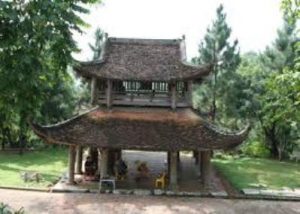
A visit demands a degree of effort: a climb of several hundred steps, a walk down an alley paved with bricks and stone, reveals a two-storey bell tower of eight elegantly corner-curved roofs. Known as the Bell Tower of Tram Gian, it still preserves its detailed art work, its supporting columns carved with intricate lotus shape, the wood panels in the shape of dragons, flowers and leaves, clouds and the sky. Under the roof hangs a 1.4m tall bell, made in 1794 on which is also carved a literary work by Tran Ba Hien from nearby Van Canh Village.
Tram Gian Pagoda, also called Tien Lu Pagoda, is situated in Tien Lu Village, Hoai Duc District, Ha Noi city.
The pagoda was was probably originally built in 1185 during the reign of King Ly Cao Tong on its present site at the top of the low Tien Lu, or Ma Hill. It nestles snugly on that hill in a natural cushion of mature trac, or kingwood and tram, or canari trees, and watched over by giant pines. It’s impressive construction and history immerse the visitor immediately: its multi-pillared temples, ornate altars, leisure areas, where mandarins would play chess with live human pieces.
At festivals the separate pavilions were given over to all-consuming and lavish praise, no more so than the Gia Ngu where the statue of Buddha was paraded during water puppet performances on the semi-circular lotus lake.
A visit demands a degree of effort: a climb of several hundred steps, a walk down an alley paved with bricks and stone, reveals a two-storey bell tower of eight elegantly corner-curved roofs. Known as the Bell Tower of Tram Gian, it still preserves its detailed art work, its supporting columns carved with intricate lotus shape, the wood panels in the shape of dragons, flowers and leaves, clouds and the sky. Under the roof hangs a 1.4m tall bell, made in 1794 on which is also carved a literary work by Tran Ba Hien from nearby Van Canh Village.
Then, and another healthy flight of stairs on, there’s the main pagoda – the legacy of the Tran Dynasty in the 14th Century but largely destroyed by the Ming invaders in the 15th and rebuilt probably during the Le Dynasty, as much as a tribute to those times.
The Pagoda is built in the architectural style, the favoured style of the Cong Chinese character in the inner part and the Quoc Chinese character in the outer. There the statues of two Guardian Spirits, the Good-encouraging Spirit and the Bad-punishing Spirit, preside and the Thien Huong, or Celestial Perfume)Seat, and in the inner part of the second house two Thuong Dien , or Upper Altars, for the praise of Buddha. A four curved-cornered and columned roof shelters a 1-metre wide drum, and an equally large gong, both dating from the 10th Year of Canh Hung (1750).
Tram Gian Pagoda is architecturally and spiritually unique – as much a place of pilgrimage for design students captured by its design and construction.
It can variously, and depending on your point of view, be seen as one entity or 100 smaller ones. It houses 153 statues mostly made of wood, some of clay red lacquered and trimmed with gold, all to the greater glory of Tam The, the Past, Present and Future Lives. A large terracotta platform supports an ornately carved altar bearing lotus flower, legends, and dragon, tiger, horse, and elephant reliefs. Nearby stands the black-lacquer jackfruit-tree wood statue of Tuyet Son styled on one found in the Himalayas. The imagery goes on at every turn: arranged and ornate altars to worship 18 Arhats and the Ruler of Hell in the Ten Great Halls, a separate pagoda and altar to worship Saint Boi or Monk Nguyen Lu also known as Binh Yen. Legend has it the statue is actually his rattan preserved body covered by an oil cloth.
